Luminescence Efficiency of Cerium Bromide Single Crystal under X-ray Radiation
Abstract
1. Introduction
2. Materials and Methods
3. Results and Discussion
4. Conclusions
Author Contributions
Funding
Data Availability Statement
Conflicts of Interest
References
- Wei, H.; Martin, V.; Lindsey, A.; Zhuravleva, M.; Melcher, C.L. The Scintillation Properties of CeBr3−xClx Single Crystals. J. Lumin. 2014, 156, 175–179. [Google Scholar] [CrossRef]
- Loyd, M.; Stand, L.; Rutstrom, D.; Wu, Y.; Glodo, J.; Shah, K.; Koschan, M.; Melcher, C.L.; Zhuravleva, M. Investigation of CeBr3−xIx Scintillators. J. Cryst. Growth 2020, 531, 125365. [Google Scholar] [CrossRef]
- Kandarakis, I. Luminescence in Medical Image Science. J. Lumin. 2016, 169, 553–558. [Google Scholar] [CrossRef]
- Xie, S.; Zhang, X.; Zhang, Y.; Ying, G.; Huang, Q.; Xu, J.; Peng, Q. Evaluation of Various Scintillator Materials in Radiation Detector Design for Positron Emission Tomography (PET). Crystals 2020, 10, 869. [Google Scholar] [CrossRef]
- Koppert, W.J.C.; Dietze, M.M.A.; Velden, S.; Steenbergen, J.H.L.; Jong, H.W.A.M. A Comparative Study of NaI(Tl), CeBr3 and CZT for Use in a Real-Time Simultaneous Nuclear and Fluoroscopic Dual-Layer Detector. Phys. Med. Biol. 2019, 64, 135012. [Google Scholar] [CrossRef] [PubMed]
- Van Loef, E.V.; Shah, K.S. Advances in Scintillators for Medical Imaging Applications. In Proceedings of the SPIE, San Diego, CA, USA, 12 September 2014; p. 92140A. [Google Scholar]
- Lecoq, P. Development of New Scintillators for Medical Applications. Nucl. Instrum. Methods Phys. Res. Sect. Accel. Spectrometers Detect. Assoc. Equip. 2016, 809, 130–139. [Google Scholar] [CrossRef]
- Higgins, W.M.; Churilov, A.; Loef, E.; Glodo, J.; Squillante, M.; Shah, K. Crystal Growth of Large Diameter LaBr3:Ce and CeBr3. J. Cryst. Growth 2008, 310, 2085–2089. [Google Scholar] [CrossRef]
- Advatech UK. Advatech UK—CeBr3. Available online: https://www.advatech-uk.co.uk/cebr3.html (accessed on 4 March 2022).
- Otaka, Y.; Shimazoe, K.; Mitsuya, Y.; Uenomachi, M.; Seng, F.W.; Kamada, K.; Yoshikawa, A.; Sakuragi, S.; Binder, T.; Takahashi, H. Performance Evaluation of Liquinert-Processed CeBr3 Crystals Coupled With a Multipixel Photon Counter. IEEE Trans. Nucl. Sci. 2020, 67, 988–993. [Google Scholar] [CrossRef]
- Kaburagi, M.; Shimazoe, K.; Kato, M.; Kurosawa, T.; Kamada, K.; Kim, K.J.; Yoshino, M.; Shoji, Y.; Yoshikawa, A.; Takahashi, H.; et al. Gamma-Ray Spectroscopy with a CeBr3 Scintillator under Intense γ-Ray Fields for Nuclear Decommissioning. Nucl. Instrum. Methods Phys. Res. Sect. Accel. Spectrometers Detect. Assoc. Equip. 2021, 988, 164900. [Google Scholar] [CrossRef]
- Linardatos, D.; Konstantinidis, A.; Valais, I.; Ninos, K.; Kalyvas, N.; Bakas, A.; Kandarakis, I.; Fountos, G.; Michail, C. On the Optical Response of Tellurium Activated Zinc Selenide ZnSe:Te Single Crystal. Crystals 2020, 10, 961. [Google Scholar] [CrossRef]
- Valais, I.; Michail, C.; David, S.; Nomicos, C.D.; Panayiotakis, G.S.; Kandarakis, I. A Comparative Study of the Luminescence Properties of LYSO:Ce, LSO:Ce, GSO:Ce and BGO Single Crystal Scintillators for Use in Medical X-Ray Imaging. Phys. Med. 2008, 24, 122–125. [Google Scholar] [CrossRef] [PubMed]
- Michail, C.M.; Koukou, V.; Martini, N.; Saatsakis, G.; Kalyvas, N.; Bakas, A.; Kandarakis, I.; Fountos, G.; Panayiotakis, G.; Valais, I. Luminescence Efficiency of Cadmium Tungstate (CdWO4) Single Crystal for Medical Imaging Applications. Crystals 2020, 10, 429. [Google Scholar] [CrossRef]
- Grinyov, B.V.; Ryzhikov, V.D.; Naydenov, S.V.; Opolonin, A.D.; Lisetskaya, E.K.; Galkin, S.N.; Lecoq, P. Medical Dual-Energy Imaging of Bone Tissues Using ZnSe-Based Scintillator-Photodiode Detectors. In Proceedings of the 2006 IEEE Nuclear Science Symposium Conference Record, San Diego, CA, USA, 29 October–4 November 2006; IEEE: San Diego, CA, USA, 2006; pp. 1945–1949. [Google Scholar]
- Ryzhikov, V.D.; Opolonin, A.D.; Pashko, P.V.; Svishch, V.M.; Volkov, V.G.; Lysetskaya, E.K.; Kozin, D.N.; Smith, C. Instruments and Detectors on the Base of Scintillator Crystals ZnSe(Te), CWO, CsI(Tl) for Systems of Security and Customs Inspection Systems. Nucl. Instrum. Methods Phys. Res. Sect. Accel. Spectrometers Detect. Assoc. Equip. 2005, 537, 424–430. [Google Scholar] [CrossRef]
- Shefer, E.; Altman, A.; Behling, R.; Goshen, R.; Gregorian, L.; Roterman, Y.; Uman, I.; Wainer, N.; Yagil, Y.; Zarchin, O. State of the Art of CT Detectors and Sources: A Literature Review. Curr. Radiol. Rep. 2013, 1, 76–91. [Google Scholar] [CrossRef]
- Hagiwara, O.; Sato, E.; Oda, Y.; Yamaguchi, S.; Sato, Y.; Matsukiyo, H.; Enomoto, T.; Watanabe, M.; Kusachi, S. Dual-Energy X-Ray Computed Tomography Scanner Using Two Different Energy-Selection Electronics and a Lutetium-Oxyorthosilicate Photomultiplier Detector. Int. J. Med. Phys. Clin. Eng. Radiat. Oncol. 2017, 6, 266–279. [Google Scholar] [CrossRef][Green Version]
- Kastengren, A. Thermal Behavior of Single-Crystal Scintillators for High-Speed X-Ray Imaging. J. Synchrotron Radiat. 2019, 26, 205–214. [Google Scholar] [CrossRef]
- Lohrabian, V.; Kamali-Asl, A.; Harvani, H.G.; Hosseini Aghdam, S.R.; Arabi, H.; Zaidi, H. Comparison of the X-Ray Tube Spectrum Measurement Using BGO, NaI, LYSO, and HPGe Detectors in a Preclinical Mini-CT Scanner: Monte Carlo Simulation and Practical Experiment. Radiat. Phys. Chem. 2021, 189, 109666. [Google Scholar] [CrossRef]
- Nassalski, A.; Kapusta, M.; Batsch, T.; Wolski, D.; Mockel, D.; Enghardt, W.; Moszynski, M. Comparative Study of Scintillators for PET/CT Detectors. IEEE Trans. Nucl. Sci. 2007, 54, 3–10. [Google Scholar] [CrossRef]
- Martini, N.; Koukou, V.; Fountos, G.; Michail, C.; Bakas, A.; Kandarakis, I.; Speller, R.; Nikiforidis, G. Characterization of Breast Calcification Types Using Dual Energy X-Ray Method. Phys. Med. Biol. 2017, 62, 7741–7764. [Google Scholar] [CrossRef]
- Koukou, V.; Martini, N.; Fountos, G.; Michail, C.; Bakas, A.; Oikonomou, G.; Kandarakis, I.; Nikiforidis, G. Application of a Dual Energy X-Ray Imaging Method on Breast Specimen. Results Phys. 2017, 7, 1634–1636. [Google Scholar] [CrossRef]
- Drozdowski, W.; Dorenbos, P.; Bos, A.J.J.; Owens, A.; Richaud, D. Gamma Radiation Hardness of Ø1″ × 1″ LaBr3:Ce, LaCl3:Ce, and CeBr3 Scintillators. In Proceedings of the 2008 IEEE Nuclear Science Symposium Conference Record, Dresden, Germany, 19–25 October 2008; pp. 2856–2858. [Google Scholar]
- van Eijk, C.W.E. Inorganic Scintillators in Medical Imaging. Phys. Med. Biol. 2002, 47, R85–R106. [Google Scholar] [CrossRef] [PubMed]
- Lecoq, P.; Annenkov, A.; Gektin, A.; Korzhik, M.; Pedrini, C. Inorganic Scintillators for Detector Systems: Physical Principles and Crystal Engineering; Lecoq, P., Ed.; Particle Acceleration and Detection; Springer: Berlin, Germany, 2006; ISBN 978-3-540-27766-8. [Google Scholar]
- Kobayashi, M.; Ishii, M.; Usuki, Y.; Yahagi, H. Cadmium Tungstate Scintillators with Excellent Radiation Hardness and Low Background. Nucl. Instrum. Methods Phys. Res. Sect. Accel. Spectrometers Detect. Assoc. Equip. 1994, 349, 407–411. [Google Scholar] [CrossRef]
- Bardelli, L.; Bini, M.; Bizzeti, P.G.; Carraresi, L.; Danevich, F.A.; Fazzini, T.F.; Grinyov, B.V.; Ivannikova, N.V.; Kobychev, V.V.; Kropivyansky, B.N.; et al. Further Study of CdWO4 Crystal Scintillators as Detectors for High Sensitivity Experiments: Scintillation Properties and Pulse-Shape Discrimination. Nucl. Instrum. Methods Phys. Res. Sect. Accel. Spectrometers Detect. Assoc. Equip. 2006, 569, 743–753. [Google Scholar] [CrossRef]
- Kozma, P.; Kozma, P. Radiation Sensitivity of GSO and LSO Scintillation Detectors. Nucl. Instrum. Methods Phys. Res. Sect. Accel. Spectrometers Detect. Assoc. Equip. 2005, 539, 132–136. [Google Scholar] [CrossRef]
- Grigoriev, D.N.; Kazanin, V.F.; Kuznetcov, G.N.; Novoselov, I.I.; Schotanus, P.; Shavinski, B.M.; Shepelev, S.N.; Shlegel, V.N.; Vasiliev, Y.V. Alpha Radioactive Background in BGO Crystals. Nucl. Instrum. Methods Phys. Res. Sect. Accel. Spectrometers Detect. Assoc. Equip. 2010, 623, 999–1001. [Google Scholar] [CrossRef]
- Valais, I.; Kandarakis, I.S.; Nikolopoulos, D.N.; Sianoudis, I.A.; Dimitropoulos, N.; Cavouras, D.A.; Nomicos, C.D.; Panayiotakis, G.S. Luminescence Efficiency of (Gd2SiO5:Ce) Scintillator under X-Ray Excitation. In Proceedings of the IEEE Symposium Conference Record Nuclear Science, Rome, Italy, 16–22 October 2004; IEEE: Rome, Italy, 2004; Volume 5, pp. 2737–2741. [Google Scholar]
- Michail, C.M.; Valais, I.; Fountos, G.; Bakas, A.; Fountzoula, C.; Kalyvas, N.; Karabotsos, A.; Sianoudis, I.; Kandarakis, I. Luminescence Efficiency of Calcium Tungstate (CaWO4) under X-Ray Radiation: Comparison with Gd2O2S:Tb. Measurement 2018, 120, 213–220. [Google Scholar] [CrossRef]
- Linardatos, D.; Velissarakos, K.; Valais, I.; Fountos, G.; Kalyvas, N.; Michail, C. Cerium Bromide Single-Crystal X-Ray Detection and Spectral Compatibility Assessment with Various Optical Sensors. Mater. Des. Process. Commun. 2022, 2022, 7008940. [Google Scholar] [CrossRef]
- Quarati, F.G.A.; Dorenbos, P.; van der Biezen, J.; Owens, A.; Selle, M.; Parthier, L.; Schotanus, P. Scintillation and Detection Characteristics of High-Sensitivity CeBr3 Gamma-Ray Spectrometers. Nucl. Instrum. Methods Phys. Res. Sect. Accel. Spectrometers Detect. Assoc. Equip. 2013, 729, 596–604. [Google Scholar] [CrossRef]
- Lin, Z.; Lv, S.; Yang, Z.; Qiu, J.; Zhou, S. Structured Scintillators for Efficient Radiation Detection. Adv. Sci. 2022, 9, 2102439. [Google Scholar] [CrossRef]
- Barta, M.B.; Nadler, J.H.; Kang, Z.; Wagner, B.K.; Rosson, R.; Cai, Y.; Sandhage, K.H.; Kahn, B. Composition Optimization of Scintillating Rare-Earth Nanocrystals in Oxide Glass–Ceramics for Radiation Spectroscopy. Appl. Opt. 2014, 53, D21. [Google Scholar] [CrossRef]
- Ackermann, U.; Eschbaumer, S.; Bergmaier, A.; Egger, W.; Sperr, P.; Greubel, C.; Löwe, B.; Schotanus, P.; Dollinger, G. Position and Time Resolution Measurements with a Microchannel Plate Image Intensifier: A Comparison of Monolithic and Pixelated CeBr3 Scintillators. Nucl. Instrum. Methods Phys. Res. Sect. Accel. Spectrometers Detect. Assoc. Equip. 2016, 823, 56–64. [Google Scholar] [CrossRef]
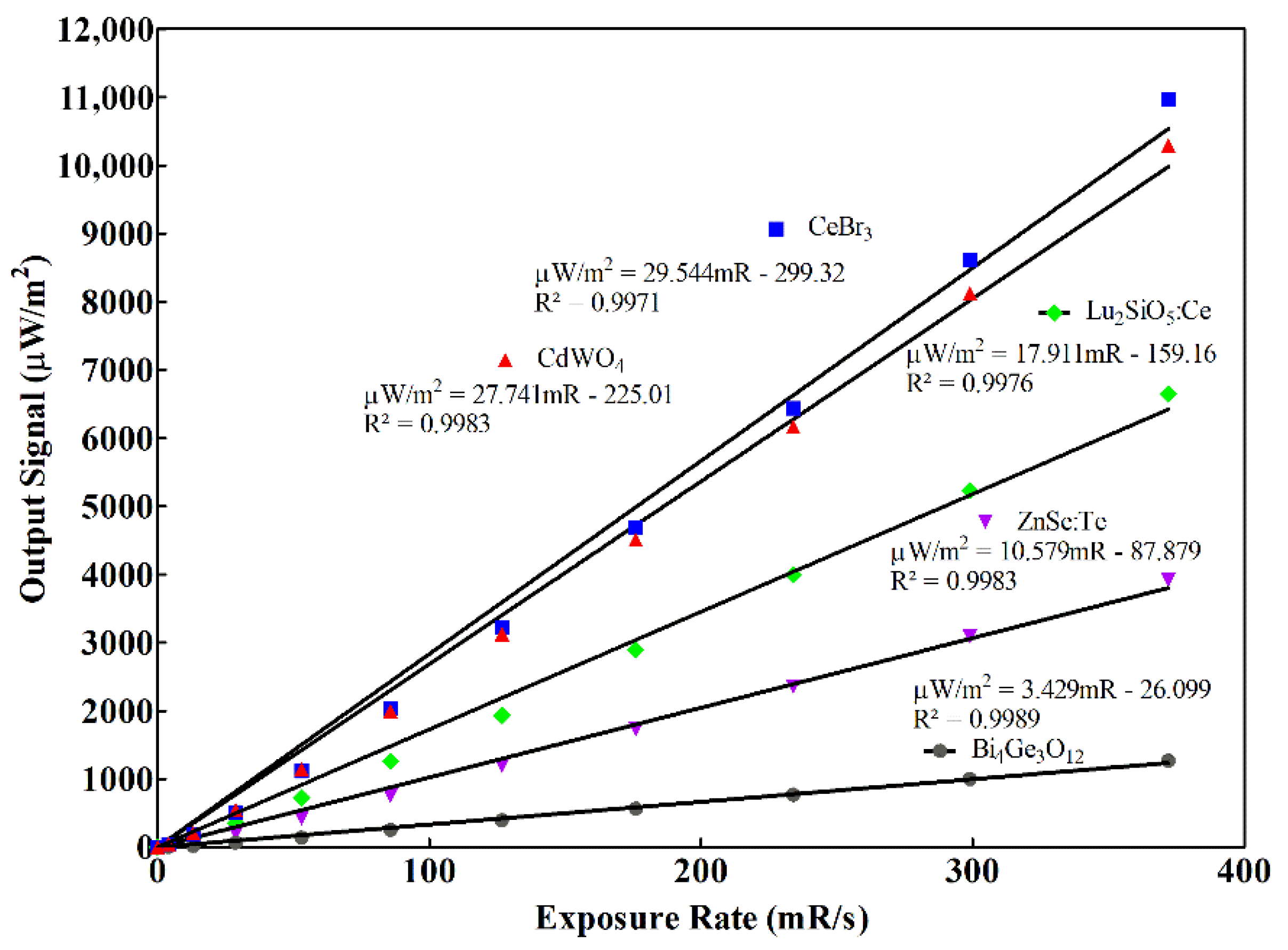
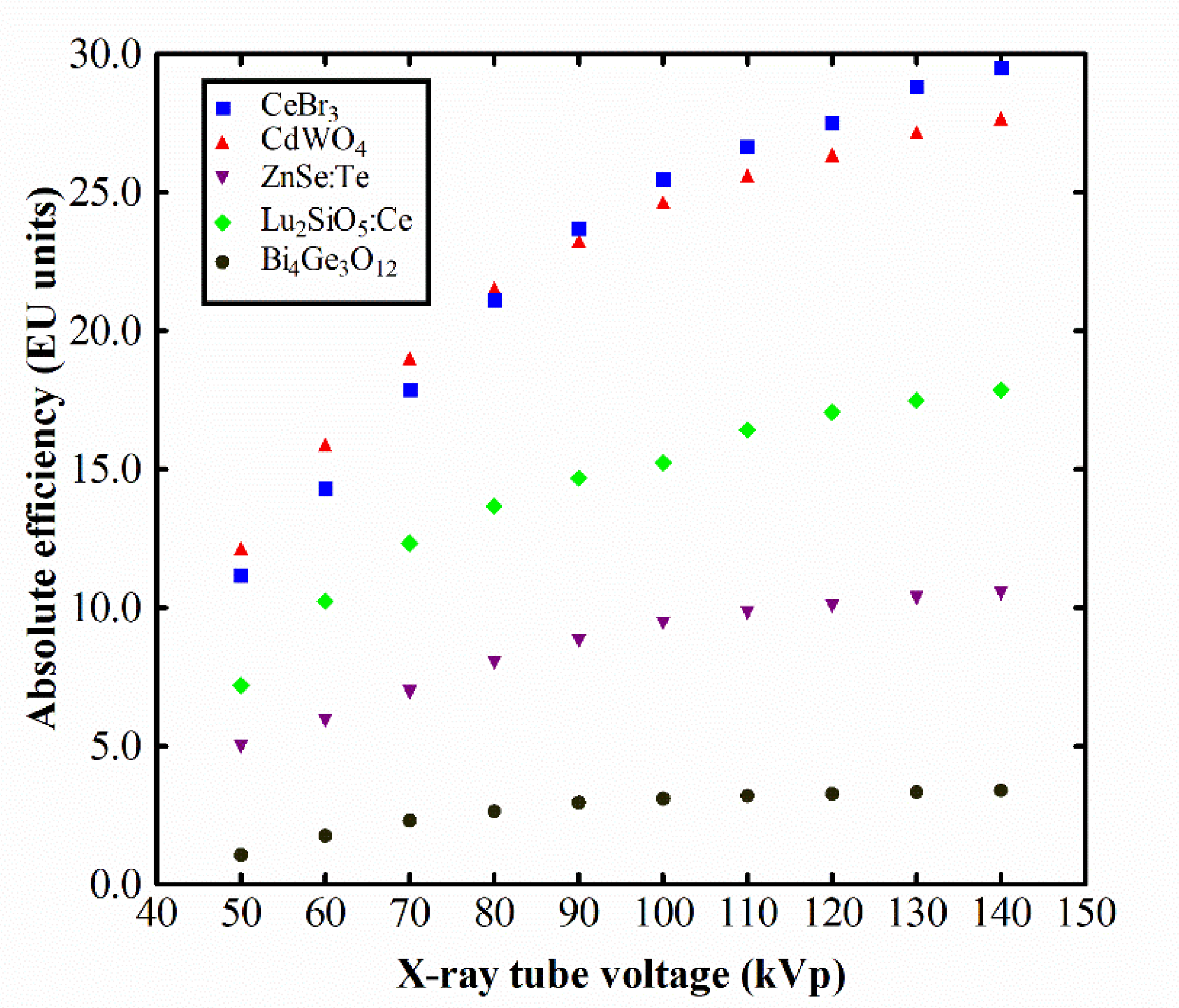
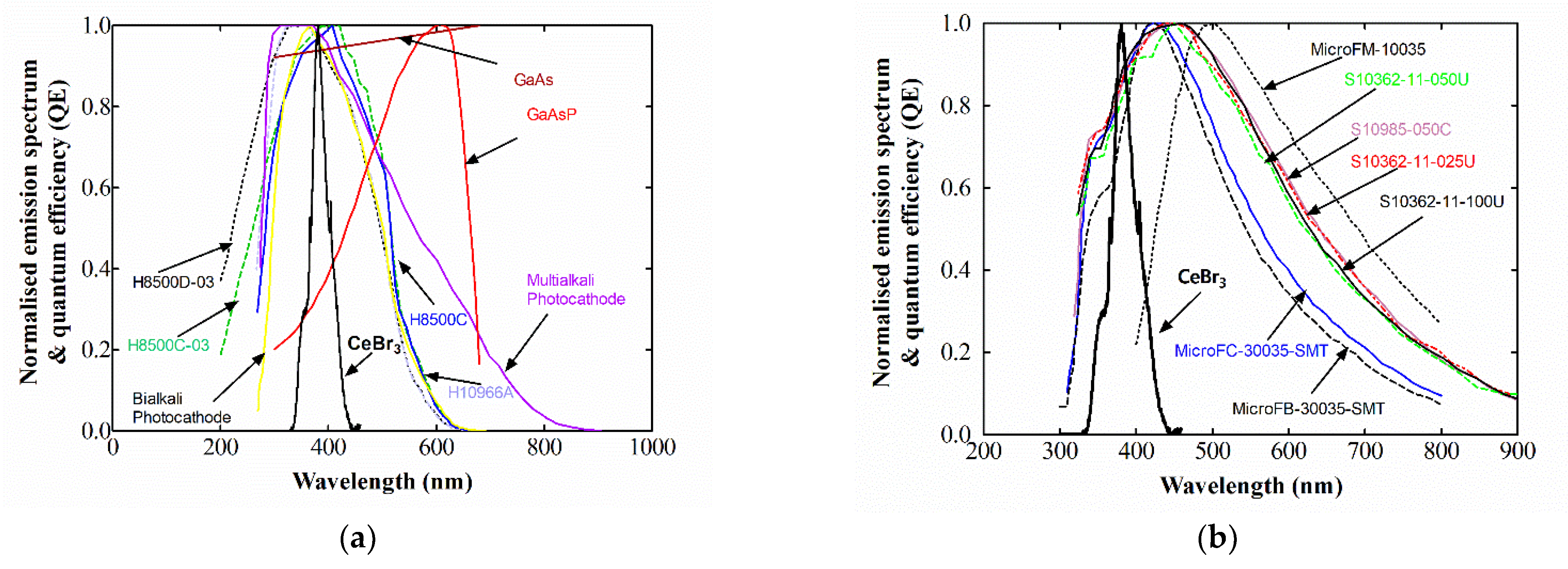
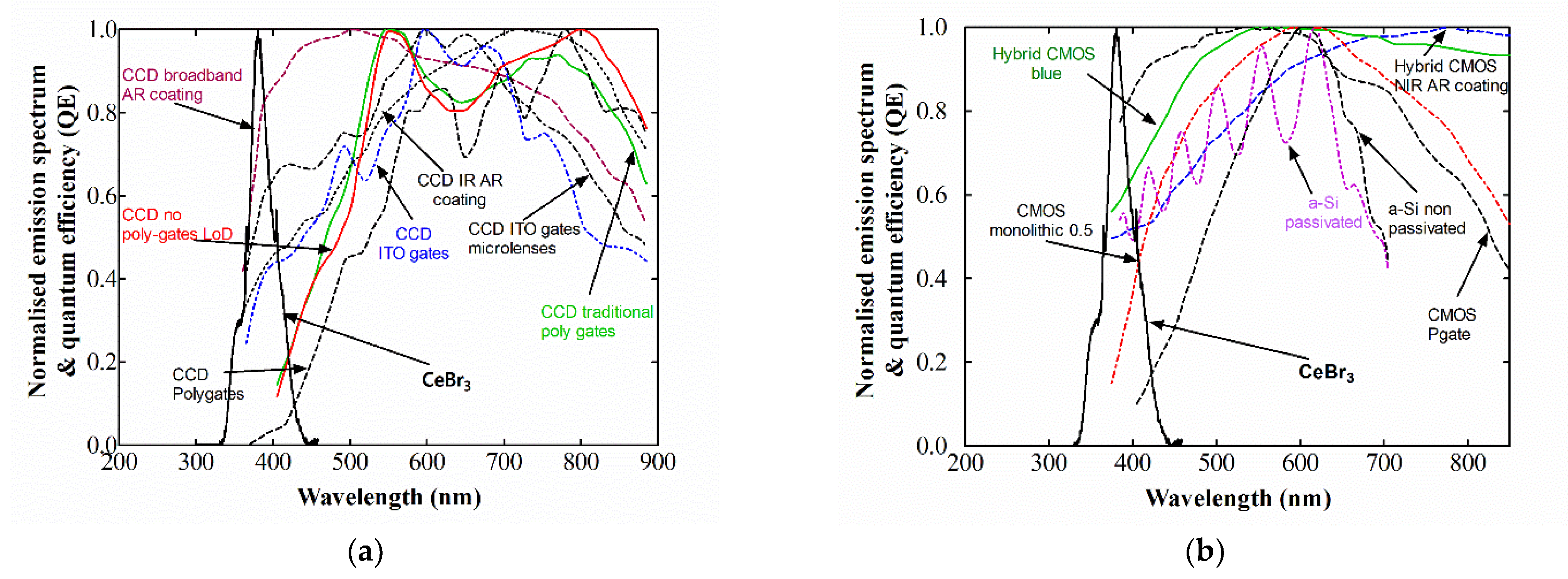
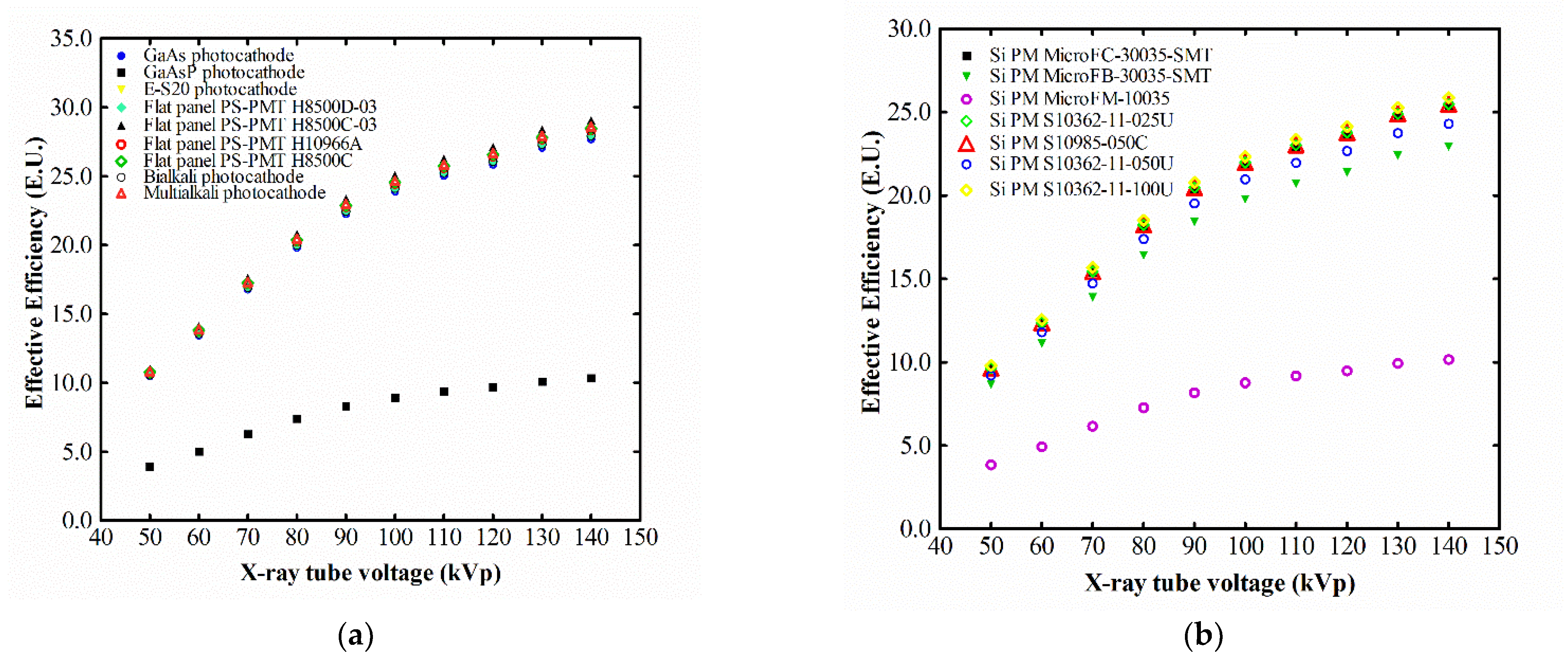
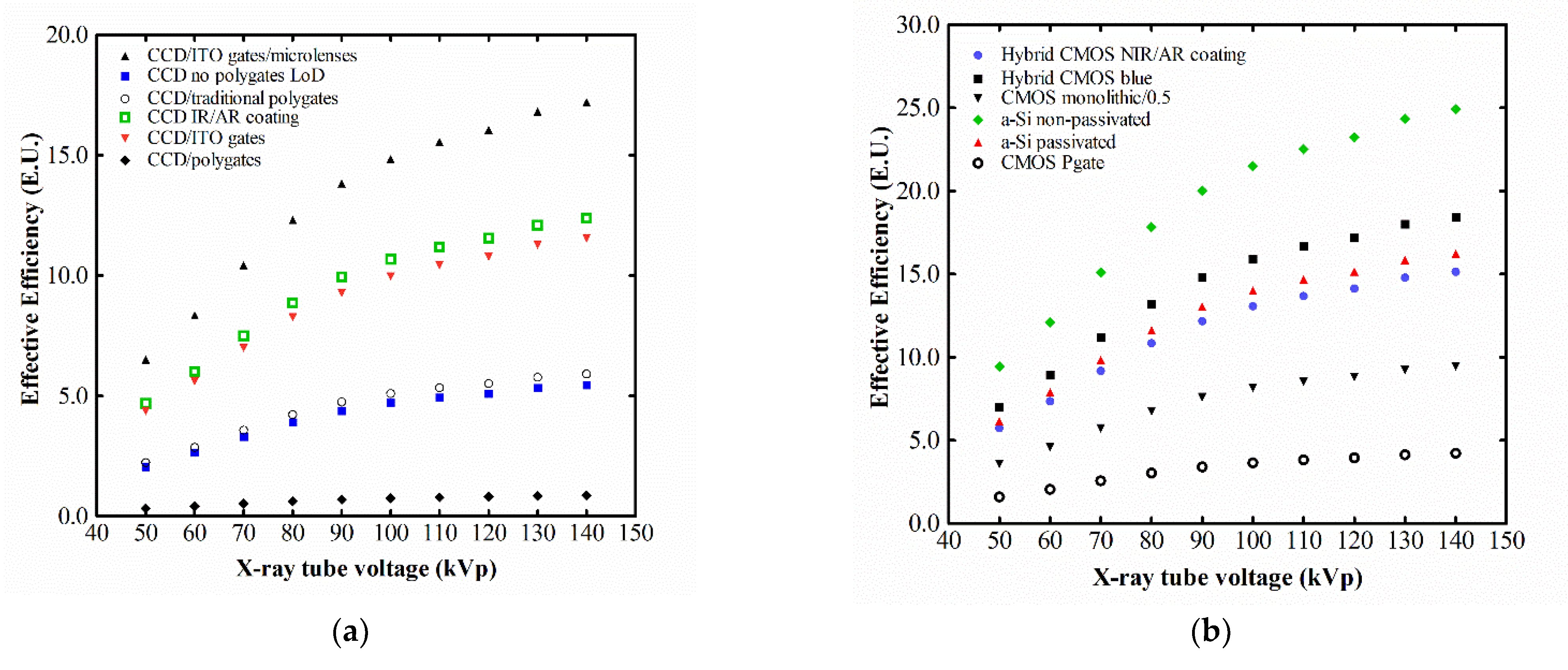
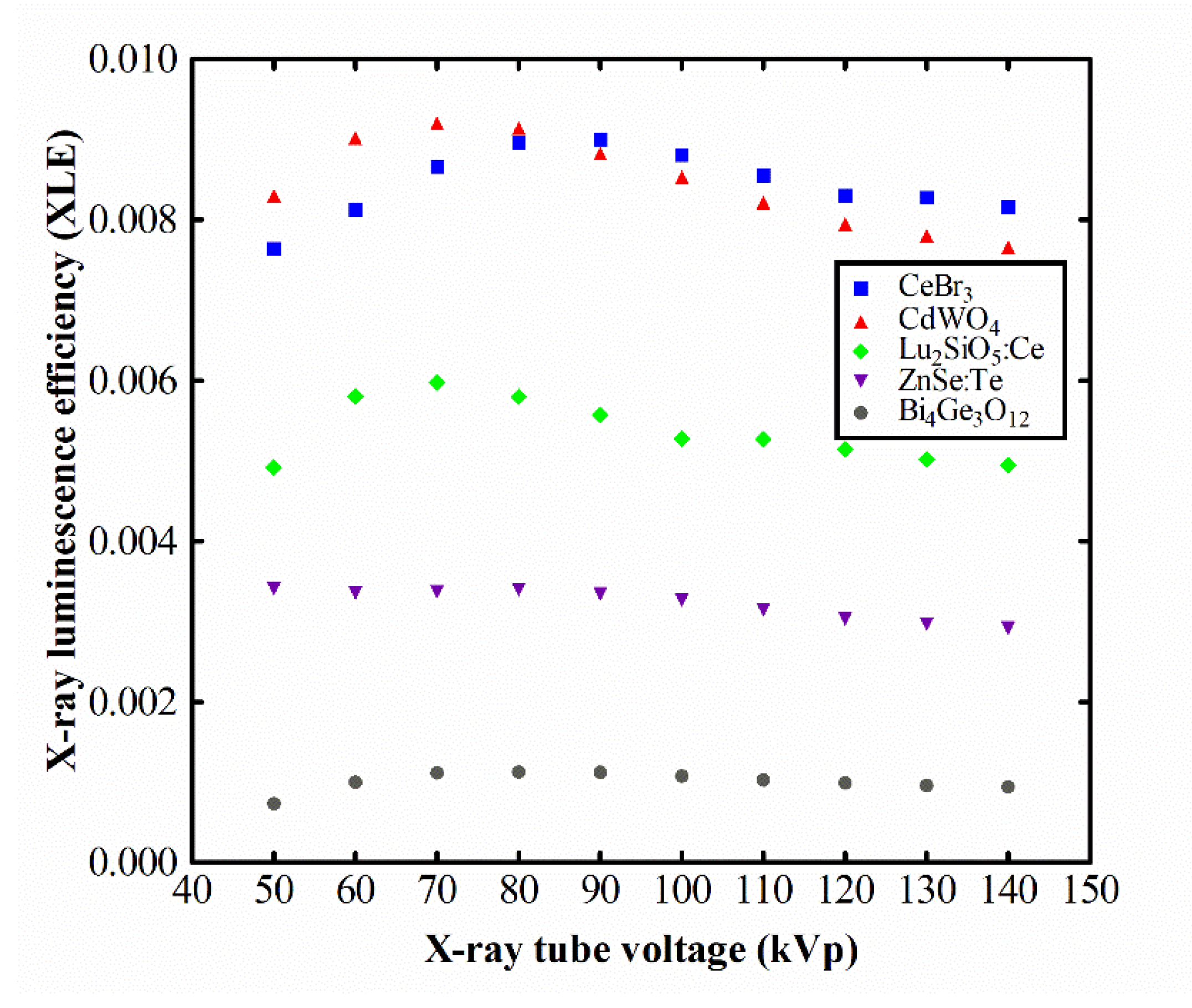
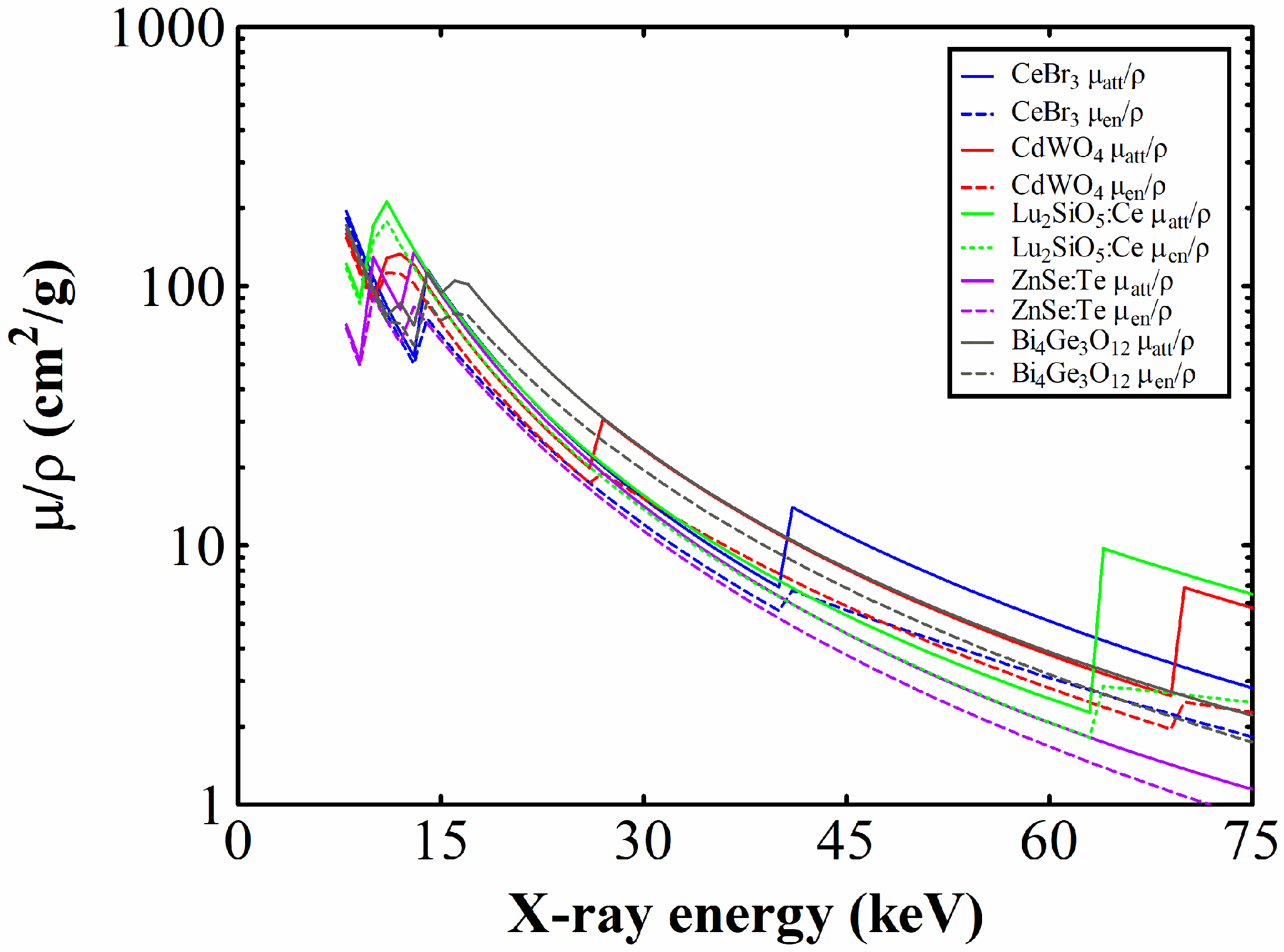
| Units | CeBr3 | CdWO4 | LSO:Ce | ZnSe:Te | BGO | |
|---|---|---|---|---|---|---|
| Wavelength of max Emission | nm | 380 | 495 | 420 | 640 | 480 |
| Emission Wavelength Range | nm | 340–425 | 380–800 | 490–520 | 525–750 | 375–650 |
| Decay Time | ns | 19 | 5 × 103 | 40 | (1–150) × 103 | 3 × 102 |
| Light Yield | photons/MeV | 6 × 104 | (1.3–2.8) × 104 | 2.7 × 103 | (2.8–16.9) × 104 | 9 × 103 |
| Photoelectron Yield | % of NaI:Tl | 122 | 30–50 | 70 | 31.5–63 | 15–20 |
| Radiation Length | cm | 1.96 | 1.1 | 1.1 | 2.23 | 1.1 |
| Background Radioactivity | Bq/cm³ | 4 × 10−3 | 8 × 10−6 | 3 × 102 | (7.1–21) × 10−3 | |
| Refractive Index @ max nm | 2.09 | 2.2–2.3 | 1.9 | 2.67 | 1.8 | |
| Afterglow | % | 0.1 @ 3 ms | <0.1 @ 2 ms | 5 @ 2 ms | <0.05 @ 6 ms | <0.1 @ 2 ms |
| Density | g/cm³ | 5.1 | 7.9 | 7.4 | 5.42 | 7.13 |
| Effective Atomic Number | 45.9 | 61–66 | 75 | 33 | 74 | |
| Melting Point | °C | 722 | 1052 | 1850 | 1779 | 1050 |
| Thermal Conductivity | Wm−1 K−1 | 5.66 | 4.69 | 3.02 | 3.7 | 11.72 |
| Thermal Expansion Coefficient | C−1 | 17.7 × 10−6 | 10.2 × 10−6 | (5–11) × 10−6 | 7.6 × 10−6 | 7.0 × 10−6 |
| Mechanical Hardness | Moh | 5–6 | 4–4.5 | 5.8 | 4 | 5 |
| Radiation Hardness | rad | 2 × 103 | 102 | 106 | 107 | 102 |
| Hygroscopic | Yes | No | No | No | No | |
| References | [5,6,7,24] | [25,26,27,28] | [7,13,19,29] | [12] | [7,29,30] |
Publisher’s Note: MDPI stays neutral with regard to jurisdictional claims in published maps and institutional affiliations. |
© 2022 by the authors. Licensee MDPI, Basel, Switzerland. This article is an open access article distributed under the terms and conditions of the Creative Commons Attribution (CC BY) license (https://creativecommons.org/licenses/by/4.0/).
Share and Cite
Linardatos, D.; Michail, C.; Kalyvas, N.; Ninos, K.; Bakas, A.; Valais, I.; Fountos, G.; Kandarakis, I. Luminescence Efficiency of Cerium Bromide Single Crystal under X-ray Radiation. Crystals 2022, 12, 909. https://doi.org/10.3390/cryst12070909
Linardatos D, Michail C, Kalyvas N, Ninos K, Bakas A, Valais I, Fountos G, Kandarakis I. Luminescence Efficiency of Cerium Bromide Single Crystal under X-ray Radiation. Crystals. 2022; 12(7):909. https://doi.org/10.3390/cryst12070909
Chicago/Turabian StyleLinardatos, Dionysios, Christos Michail, Nektarios Kalyvas, Konstantinos Ninos, Athanasios Bakas, Ioannis Valais, George Fountos, and Ioannis Kandarakis. 2022. "Luminescence Efficiency of Cerium Bromide Single Crystal under X-ray Radiation" Crystals 12, no. 7: 909. https://doi.org/10.3390/cryst12070909
APA StyleLinardatos, D., Michail, C., Kalyvas, N., Ninos, K., Bakas, A., Valais, I., Fountos, G., & Kandarakis, I. (2022). Luminescence Efficiency of Cerium Bromide Single Crystal under X-ray Radiation. Crystals, 12(7), 909. https://doi.org/10.3390/cryst12070909










